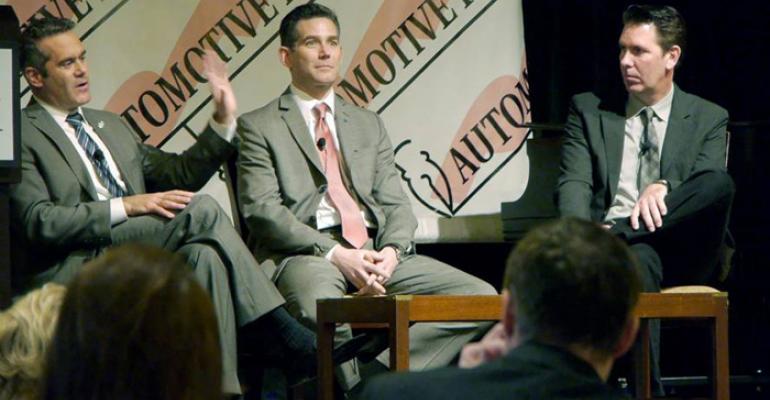DETROIT – Car buyers’ expectations about new technologies have grown so much in recent years that auto makers would face a showroom revolt if they tried to remove such content to more easily meet safety and fuel-economy regulations, leading industry designers say.
“They’ve started taking it for granted,” Michael Arbaugh, an interiors studio design manager at Ford, says of consumers. “They have certain expectations.”
Arbaugh recalls a day not long ago when even one power source in a vehicle to operate a radar detector or charge a cellular telephone was rare. These days, consumers demand multiple outlets for an array of electronic mobile devices.
“That was Jetsons-like technology 30 years ago,” he tells the Michelin Automotive Design Panel at a meeting of Automotive Press Assn. here. “Look at it now.”
The same goes for the adjustable-suspension settings on performance cars, offers Mark Trostle, head of design for Chrysler’s SRT brand and leading the revival of the high-performance Viper. “Think about 2- and 3-mode adjustable suspensions and how much weight goes into each corner with that,” he says.
But dare to take technology away to lighten a vehicle and meet tightening government safety fuel-economy rules, and customers will walk away.
“You can’t take content away; (the vehicles) won’t sell,” says Bob Boniface, director- Cadillac exterior design at General Motors. “People expect more and more content,” he adds, especially on larger vehicles.
Boniface, who helped keep weight down in the design of the Chevrolet Volt extended-range electric vehicle, suggests attacking parts consolidation instead. “Reduce the complexity of the part.”
Ironically, consumers also continue to demand seemingly antiquated technologies for their cars, such as compact-disc players.
Arbaugh says Ford found it could take 5 lbs. (2.2 kg) out of a vehicle by removing the CD player, but customers pushed back. “Big car, small car; they want everything.”
The dilemma over what to keep and what to quit rages every day among decision-makers at Ford, he says. “It’s a give-and-take. It’s like decorating your home with your spouse. It’s about compromises.”
The panelists here admit they would like to see regulators tinker with some rules, such as the test procedure for pedestrian protection, but they stop short of asking the government to repeal some current and coming safety and fuel-economy standards.
“We can make cars that look good, are fun to drive and are safe,” Boniface says.
Besides, adds Arbaugh, the challenge of designing to meet government standards spurs the innovations underpinning the industry and makes for a satisfying day’s work. “It’s the difference between going to design school and styling.”
Small cars present the greatest challenge aerodynamically, the designers say, although items such as active grille shutters are helping them make compact and subcompact vehicles slipperier.
The price of lightweight carbon fiber is falling, as well, making it easier to take heft out of a vehicle, but extensive use remains reserved for high-end products, they say.
The new Viper, for example, will use 44% carbon fiber on key parts and provide Chrysler with valuable lessons for application on volume vehicles. “Doing a supercar is a good way for us to learn as a company,” Trostle says.
Boniface expects more OEMs will follow GM’s lead in establishing collaborations with carbon-fiber suppliers, as it did with Japan’s Teijin last year, which will drive cost down more quickly.
The designers would like to see regulations in China, the U.S. and the European Union become more harmonized as GM, Ford and Chrysler create more vehicles off global platforms. Even seemingly innocuous rules, such as where to place the license-plate cavity, increases cost because a myriad of safety sensors occupy front and rear fascias.
“That would be a huge efficiency improvement for the market,” Trostle says of uniformity in regulations that transcends geographic boundaries. “Right now, we have to design fascias for export that are different from (the U.S.). We are doubling up on so many different things.”





